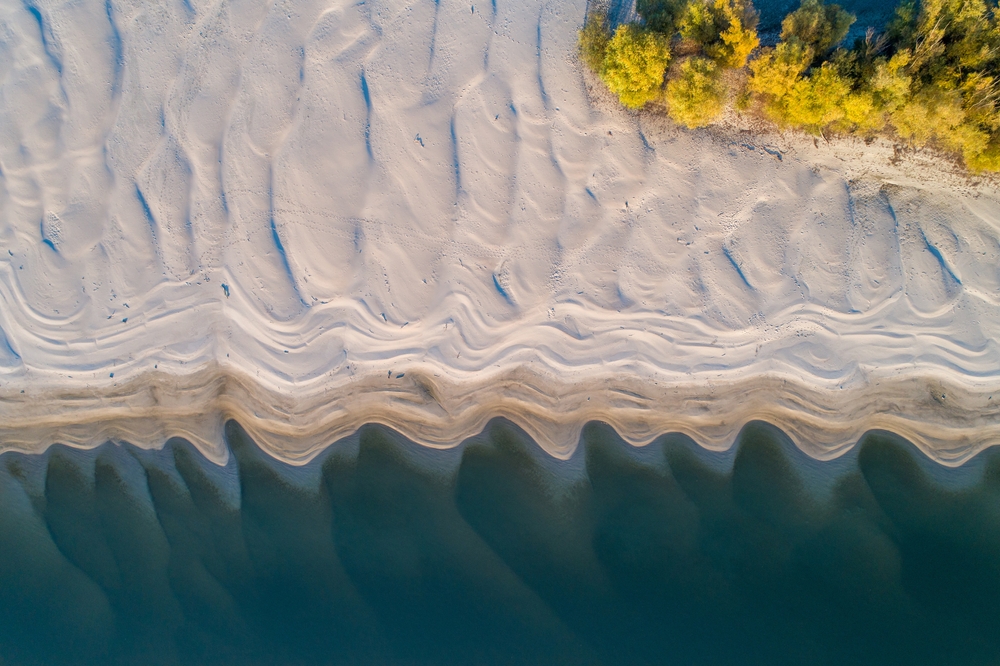Adriatic-Ionian Region: in search of ecological corridors
Green infrastructure, ecological corridors. What are they and how could they contribute to improving the environment in the Adriatic-Ionian region? We talked about it with Senad Oprasic, head of the environmental protection department of the Ministry of Foreign Trade and Economic Relations of Bosnia and Herzegovina and coordinator of one of the thematic areas of EUSAIR

Regione-Adriatico-Ionica-alla-ricerca-dei-corridoi-ecologici
Aerial view of the Danube - © Budimir Jevtic/Shutterstock
Green infrastructure is defined by the European Commission as “a strategically planned network of natural and semi-natural areas with other environmental elements, designed and managed to provide a broad spectrum of ecosystem services. It includes green spaces (or blue, in the case of aquatic ecosystems) and other physical elements in land and marine areas”.
"It is therefore an essential element for improving the quality of the environment and, consequently, the quality of life – stresses Senad Oprasic, coordinator of the environment working group dedicated of the EUSAIR macro-regional strategy – in fact, it favours the adoption of natural solutions to current problems by providing numerous ecosystem services including maintenance and balancing, purification and nutrient retention services. Its role is first of all to strengthen the resistance of the environment to pollution and to accelerate the process of environmental recovery".
With seven of the nine countries participating in the strategy having an outlet to the sea, EUSAIR pays particular attention to blue as well as green infrastructure. "The European Union has recognised the importance of including the concept of the blue corridor among the measures necessary to improve the connectivity of ecological networks and to ensure the sustainability of fishing and navigation in marine ecoregions. The next step will be to include this idea in national and local planning. With EUSAIR we have developed important tools to achieve this goal thanks to projects such as the EUSAIR Facility Point and PORTODIMARE", explains Senad Oprasic.
The Adriatic-Ionian region is a large reserve of biodiversity, always under pressure. "In order to be in line with the EU Biodiversity Strategy, 30% of the Adriatic should be protected, while 10% should be reinforced. To date, only 3.57% of the Adriatic is protected, while strictly protected areas amount to 0.07%. And it is precisely through the Facility Point project that EUSAIR is working on the establishment of cross-border marine protected areas. It is essential to create awareness in the governments of the region about the need to establish these protected areas for the protection of traditional fishing", continues Oprasic, who then highlights how the establishment of a network of marine protected areas has, among other things, a significant economic impact.
The EU Biodiversity Strategy for 2030 aims to reverse the loss of biodiversity with the ultimate ambition to restore all the planet’s ecosystems by 2050. The strategy therefore defines Europe’s contribution to achieving this goal, setting how the first goal is the recovery of biodiversity by 2030, in line with the United Nations Agenda 2030. Adopted in May 2020, the European strategy takes into account the pandemic and its consequences, and should be central to the recovery of the EU and its member states. In this context, EUSAIR plays an important role in facilitating cross-border cooperation in the establishment and protection of protected areas. The protection of biodiversity promoted by EUSAIR is also intertwined with Natura 2000, the network created by the European Union for the protection of habitats and the conservation of biodiversity, with particular attention to threatened or rare species of flora and fauna. With land coverage of 18% and marine coverage of 8%, the Natura 2000 network is the European face of green infrastructure. A territorial analysis of the Adriatic-Ionian region published in 2020 shows how the Natura 2000 network is very extensive in the macro-region, as it includes 3,027 sites for a total of 117,993 square kilometres in the EU member countries, and 1,338 in the candidate countries with a total extension of 16,894 square kilometres.
The EUSAIR macro-regional strategy also has many points in common with many other European policies. This element facilitates the alignment of candidate countries for entry into the European Union with the required requirements, which can be summarised in the acquis communautaire. EUSAIR can therefore play a great role in aligning the candidate countries with the acquis, as we illustrated in a recent study conducted in collaboration with CeSPI on the role of the EUSAIR strategy in the enlargement process to the Western Balkans.
This facilitating role also plays out in the environmental field, where the supranational dimension of the issues is more apparent than elsewhere. “After all, if we take ecological corridors for example, they don’t stop at national borders. The introduction of these concepts therefore amounts to promoting integration between countries and in the entire macro-region", explains Oprasic. Green infrastructure can therefore be an important instrument and an opportunity to take steps towards an enlarged and green Europe.
This content is published in the context of the “Work4Future” project co-financed by the European Union (EU). The EU is in no way responsible for the information or views expressed within the framework of the project. The responsibility for the contents lies solely with OBC Transeuropa. Go to the “Work4Future“
Tag: Work for Future
Featured articles
- Take part in the survey
Adriatic-Ionian Region: in search of ecological corridors
Green infrastructure, ecological corridors. What are they and how could they contribute to improving the environment in the Adriatic-Ionian region? We talked about it with Senad Oprasic, head of the environmental protection department of the Ministry of Foreign Trade and Economic Relations of Bosnia and Herzegovina and coordinator of one of the thematic areas of EUSAIR

Regione-Adriatico-Ionica-alla-ricerca-dei-corridoi-ecologici
Aerial view of the Danube - © Budimir Jevtic/Shutterstock
Green infrastructure is defined by the European Commission as “a strategically planned network of natural and semi-natural areas with other environmental elements, designed and managed to provide a broad spectrum of ecosystem services. It includes green spaces (or blue, in the case of aquatic ecosystems) and other physical elements in land and marine areas”.
"It is therefore an essential element for improving the quality of the environment and, consequently, the quality of life – stresses Senad Oprasic, coordinator of the environment working group dedicated of the EUSAIR macro-regional strategy – in fact, it favours the adoption of natural solutions to current problems by providing numerous ecosystem services including maintenance and balancing, purification and nutrient retention services. Its role is first of all to strengthen the resistance of the environment to pollution and to accelerate the process of environmental recovery".
With seven of the nine countries participating in the strategy having an outlet to the sea, EUSAIR pays particular attention to blue as well as green infrastructure. "The European Union has recognised the importance of including the concept of the blue corridor among the measures necessary to improve the connectivity of ecological networks and to ensure the sustainability of fishing and navigation in marine ecoregions. The next step will be to include this idea in national and local planning. With EUSAIR we have developed important tools to achieve this goal thanks to projects such as the EUSAIR Facility Point and PORTODIMARE", explains Senad Oprasic.
The Adriatic-Ionian region is a large reserve of biodiversity, always under pressure. "In order to be in line with the EU Biodiversity Strategy, 30% of the Adriatic should be protected, while 10% should be reinforced. To date, only 3.57% of the Adriatic is protected, while strictly protected areas amount to 0.07%. And it is precisely through the Facility Point project that EUSAIR is working on the establishment of cross-border marine protected areas. It is essential to create awareness in the governments of the region about the need to establish these protected areas for the protection of traditional fishing", continues Oprasic, who then highlights how the establishment of a network of marine protected areas has, among other things, a significant economic impact.
The EU Biodiversity Strategy for 2030 aims to reverse the loss of biodiversity with the ultimate ambition to restore all the planet’s ecosystems by 2050. The strategy therefore defines Europe’s contribution to achieving this goal, setting how the first goal is the recovery of biodiversity by 2030, in line with the United Nations Agenda 2030. Adopted in May 2020, the European strategy takes into account the pandemic and its consequences, and should be central to the recovery of the EU and its member states. In this context, EUSAIR plays an important role in facilitating cross-border cooperation in the establishment and protection of protected areas. The protection of biodiversity promoted by EUSAIR is also intertwined with Natura 2000, the network created by the European Union for the protection of habitats and the conservation of biodiversity, with particular attention to threatened or rare species of flora and fauna. With land coverage of 18% and marine coverage of 8%, the Natura 2000 network is the European face of green infrastructure. A territorial analysis of the Adriatic-Ionian region published in 2020 shows how the Natura 2000 network is very extensive in the macro-region, as it includes 3,027 sites for a total of 117,993 square kilometres in the EU member countries, and 1,338 in the candidate countries with a total extension of 16,894 square kilometres.
The EUSAIR macro-regional strategy also has many points in common with many other European policies. This element facilitates the alignment of candidate countries for entry into the European Union with the required requirements, which can be summarised in the acquis communautaire. EUSAIR can therefore play a great role in aligning the candidate countries with the acquis, as we illustrated in a recent study conducted in collaboration with CeSPI on the role of the EUSAIR strategy in the enlargement process to the Western Balkans.
This facilitating role also plays out in the environmental field, where the supranational dimension of the issues is more apparent than elsewhere. “After all, if we take ecological corridors for example, they don’t stop at national borders. The introduction of these concepts therefore amounts to promoting integration between countries and in the entire macro-region", explains Oprasic. Green infrastructure can therefore be an important instrument and an opportunity to take steps towards an enlarged and green Europe.
This content is published in the context of the “Work4Future” project co-financed by the European Union (EU). The EU is in no way responsible for the information or views expressed within the framework of the project. The responsibility for the contents lies solely with OBC Transeuropa. Go to the “Work4Future“
Tag: Work for Future










